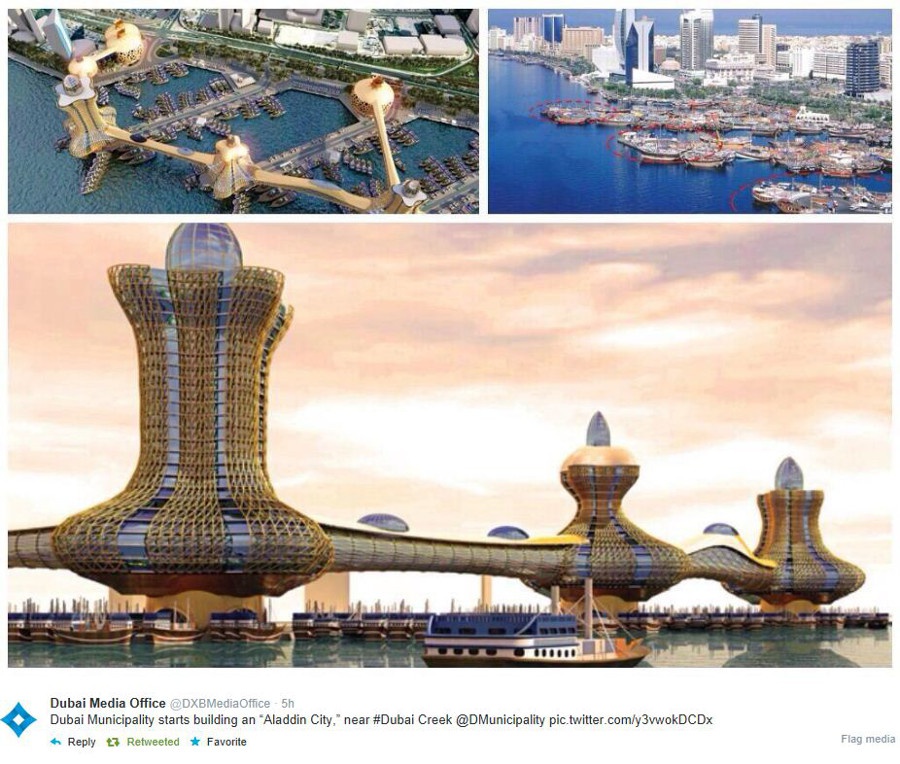This article was originally published in Ibraaz’s Platform 009.
Aladdin City draws upon a deep reverence for the region’s history, beginning with its iconic name. The legends of Aladdin and Sinbad are a driving force in the project’s architecture – main thoroughfares will be designed to resemble exotic marine life and fantasy animals such as dragons at their exterior. Consequently, the towers themselves seem to draw inspiration from tales of Aladdin’s lamp in the project’s concept drawings.[1]
On 12 February 2015, a development project called Aladdin City was launched, or relaunched, thanks to an earlier “sidelines” talk between two people paid by Dubai’s government: Dubai Municipality’s director-general and an employee from the government-owned daily Emirates 24|7.[2] After the daily published an article about Aladdin City, a social-media blitz gathered around the project, mostly limited to caffeinated and hungry click-baiting sites and British tabloids, all of which seemed to base their flimsy reporting on (and gather the jpegs from) the original article in the Dubai daily. Beyond the usual derivative article addended with exclamations like “next up on the list [for] Dubai’s skyline!” the obscure website Clapway managed to get more, if not well-worded, information on the project as quoted above.
As the name of the 16-square-kilometre project might suggest, Aladdin City’s architecture is said to take its formal cues from The Arabian Nights tales. For many reasons, the project shouldn’t come across as too shocking, if one follows any news on Dubai’s development pursuits. Its scale is not surprising: three towers of 25 to 34 storeys. The commercial space seems huge at 110,000 square metres (that’s about the amount of leasable floor area in New York City’s Chrysler Building), but that number could always be downsized after the press campaign. Dubai’s media office has suggested on Twitter that the municipality will fund it (though there is no published cost estimate) and begin construction in 2016. The four-year time frame to complete the project seems achievable; in not much more time than that, Dubai investors are promising an entirely new 700-square-kilometre capital district outside Cairo. Another element of the project that has yet to cause dismay is the fact that it is planned on the current site of Port Saeed, the mooring station for ships that still maintain a semblance to the vessels that once entered the harbour a century ago. According to other news reports, the ships are scheduled to disappear from view.
Aladdin City, however, isn’t immune to criticism, at least not online. If there were an approved global taste for architecture defined by social media feeds, this set of buildings would not fit the bill. Its outlandishness (gilded mesh and unsophisticated curves, for example) is an affront to acclaimed modern sensibilities. There is no available information about an architect or designer associated with the project to answer to such aesthetic malfeasance. Still, there must be designers for the project even if they are just rendering technicians. Whatever kind of designers created the images that have circulated online, the references that they have tapped into are not moods or settings of an Arabian tale or two. Instead, they are props from the tales that weren’t buildings to begin with: they might be tea or coffee pots, perfume bottles or a chain of genie lamps. In the end, the buildings are hardly oversized replicas in the form of architecture.[3] They suffer from being neither literal nor figurative allusions to the tales.
In trying to figure out how “exotic marine life and fantasy animals” might eventually take architectural form, there is much here to cause one to chuckle, if however smugly (“So Dubai!”). Rather than proclaiming these kinds of projects as absurd (for example, extenuations of the coastline into the shapes of palms, underwater resorts (and tennis venues), and Ferris-wheel hotels), I’m more interested in mining them for potential meaning. In the process, Dubai often emerges numbingly mundane but more intricately layered at the same time. Smugness is a temptation that could deter one from exploring richer investigations and discovering more significant matters in Dubai.
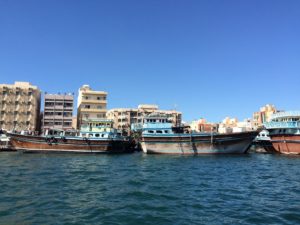
Dhows on Dubai Creek, 2014. Photo: Todd Reisz
Online discussion forums host debates on whether Aladdin City will ever be built, with little evidence to bolster one side or the other. A YouTube video, dated to 2012, includes clips of Dubai’s ruler Sheikh Mohammed bin Rashid al Maktoum and his retinue reviewing the project among others that have most recently been announced as part of the city’s ambitions to amaze during its 2020 hosting of the World Expo.[4] From the video, one might assume that the Maktoum family has a direct role in this project’s development. That would not be surprising, since the land from which Port Saeed was carved was made from reclaimed land produced by dredging the creek during its transformation into a modern harbour. Snippets of historical storytelling reveal that the land, however, was eventually given to the Lootah family upon their return to Dubai from nearby Ajman. According to some sources, the head of the Lootah family, Saeed Bin Ahmed Al Lootah, did not name the port after himself but in the memory of Egypt’s Port Said, damaged during the Tripartite Aggression (or Suez Crisis) in 1956. Before and after 1956, Egypt’s port, a city in fact, was much larger than the three-piered wharfage on Dubai Creek. Today, the Lootah family continues as one of the so-called merchant families of Dubai. Hussain Nasser Lootah, in fact, is the director-general of Dubai Municipality who discussed the project with the Emirates 24|7 reporter. Dubai might be experiencing yet another private-public partnership for which it is so often known.
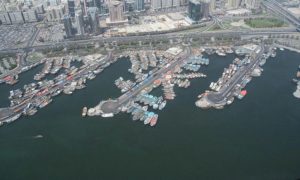
Aerial view, Port Saeed in Deira. Each of Aladdin City’s towers are proposed to rise atop the three piers.
But just as unanswerable as the question of to whom this project belongs, is the question of why The Arabian Nights has been given such a prominent position in shaping Dubai’s waterfront architecture and reorganizing the city’s own geopolitics. What about this proposal, if anything, exhibits “a deep reverence for the region’s history”? There are various suppositions about the provenance of a historical character upon which the tales of Sinbad are based, including current-day Iraq, Oman, Yemen and Kuwait. And now it would seem that, through a fantastical development, Dubai’s shapers want to claim their own connection to Sinbad, a mostly mythological character, and then a genie to boot.
Business strategies for Dubai have most often focused on distinguishing the city among other Gulf cities. So why is there now the need to seek regional camaraderie through a set of buildings on one of the very sites that signified the city’s exception among its regional competitors? In other words – why is Dubai calling up a questionable history when it has a real and fascinating port history right there on site, and one that is at risk of being erased? Who will be convinced by a project that takes The Arabian Nights as both its formal and historical source?[5] While many in the Arab World would be bemused by Aladdin City’s reference to a supposedly “Arab culture,” others might point to the irony, or at the least the conflict of intentions, in the proposal. Along the Arabian coast of the Persian Gulf, references to the tales of The Arabian Nights come with the risk of discussing cultural and ethnic mixing – that is, the stories of Arabian nights are hardly just Arabian. They are also Persian, connected to current-day Pakistan and India, and reach as far as places not excluding China and Mongolia with the added meta-structure provided by French Orientalism.[6] These stories continue to thrive in a global imagination because of their cultural mongrelism.
Beyond the project’s appropriation of a regional mythology, for whom is this project being proposed? Who will buy or rent property in these buildings? Who would be attracted to their shops? Can such a project speak to local Emiratis? Can it speak to expatriate Arabs or expatriate Iranians or Pakistanis? Or does it resolve to play with the fantasies of travellers from Europe, Southeast Asia, and North America, who look for some kind of modern transmutation of their hopes and expectations of smelling what William Wordsworth described as ‘”sweet … odours caught by him who sails / Near spicy shores of Araby …”? If that is the case, visitors will do so within the comfortable confines of air-conditioned walkways with views over Dubai’s node in global trade routes that prove too hot for their coiffured selves to experience beyond the glass partition.
Or is the ploy to feed into an external industry that will see Dubai in however way it wants to be seen? Is Dubai simply lifting the mirror and letting its weary Western travellers get a taste of what they had expected? (The cliché persists of Dubai as a “mirage’” or another tale of the Arabian nights. Publicist-driven press accounts suggest that the likes of Prince Harry and Kylie Minogue will be enjoying an “Arabian Night” in Dubai or another Gulf city.) Ever since the first strides of modernization in the 1960s, ambitions out of Dubai have played with notions of the “world as exhibition,” flirting with assumptions made by outside viewers as a business transaction.[7] But how far can Dubai trade in Orientalist platitudes before they become a liability?
Anthropologist Neha Vora points out in her recent book Impossible Citizens that leadership in Dubai is interested in “the production of cosmopolitan futures and the erasure of cosmopolitan pasts.”[8] Those cosmopolitan futures place Dubai in a formulated narrative which is part of the 44-year-old nationalism project called the United Arab Emirates and which seeks to define an Emirati culture, an Emirati people, against a historical and contemporary backdrop that has in its cast myriads of nationalities and sub-nationalities who have resided and continue to reside within the country’s boundaries. As early as the 1950s, more than half of Dubai’s population was made up of people considered to be foreigners (many didn’t carry a passport, though). In terms of Aladdin City, the erasure of a cosmopolitan past might include the vast number of kinds of people who contributed to making Dubai a successful port. If that’s the case, the cosmopolitan past is being replaced not by a cosmopolitan future but by a cosmopolitan fantasy, and one that is certainly not (only) Emirati.
This fantasy is scheduled exactly at the site of erasure: Khor Dubai, what is known in English as Dubai Creek. Why it was ever called a creek is not clear; it is more like an estuary and it was once the commercial lifeline of Dubai. During its most essential years, through the 1960s, it was also called Dubai Harbour. Western, mostly British, observers were often smitten with Dubai’s active port up through the late 1950s, where the city’s less than modest buildings and packed sand pathways belied the port’s teeming commercial success. It seemed no English-speaking observer could describe the port without the word “bustling.” Dubai was the largest town in the region. But that wasn’t saying a lot – by 1950 its population likely didn’t exceed 30,000 and even such a small population was already defined more by its immigrants or, more accurately, those people passing through. Dubai’s demographic makeup was already how it would be defined up to the present: a majority of the population came from somewhere else and would eventually go somewhere else.
It is said that European travellers of the Middle East sometimes ended up in Dubai because Cairo and Damascus had too many tourists. At the beginning of its modernization programme, Dubai’s port conjured up images of ancient traditions of trade: of a pre-modern world that seemed to have disappeared everywhere else but in a few ports. Dubai’s ancientness was not a natural state; it was as artificial as anything we might find in Dubai today, designed by an occupying British authority that found such a non-modern condition easier to control. One visiting British traveller remarked:
[The harbour’s] markets are the most picturesque I have ever seen in the Middle East and take one back to the time of Arabian Nights. In the narrow lanes roofed with matting, where the gloom is flecked by spots of sunlight, Arabs, Persians, and Baluchis display their multifarious and many-coloured wares. … Conditions are no doubt primitive, but there is an air of bustle and prosperity about the place that gives it a peculiar charm.[9]
A travelling Briton might find “charm” in Dubai’s tableau of headdresses, daggers and dhows (the traditional sailing vessels of the Indian Ocean). The truth was, however, that by the late 1950s Dubai was in no condition for continuing as a truly thriving port. The port was rarely the final destination for arriving goods or people; it functioned as a transitional hub that aided the British Empire’s trade networks and other networks that Dubai’s merchants were discovering on their own. The in-between was not only undeveloped but it was more importantly undefined – a purposely haphazard condition open to modification and profit. But it was a liminal existence that could no longer be sustained, at least according to the British administrators and engineers assembled to affect its course.
Around 1955, British government officials started to see their presence in the region as too costly. After almost a century of being maintained under a pre-modern rhetoric, Dubai was scripted for change. The British governmental oversight in the region – represented by an officer called a political agent – was charged with seeing to Dubai’s modernization, if on an extraordinarily limited budget. Part of the process included getting Sheikh Rashid – the Ruler of Dubai – to commission from his own checkbook an architect to draw Dubai’s first town plan in 1959. The plan was issued the following year. It not only lent the city a semblance of order and modern organization but also provided the board on which Dubai’s real estate game would begin. With land now converted into apportioned lots the British Bank of the Middle East, recently stationed on Dubai Creek, could dole out mortgages.
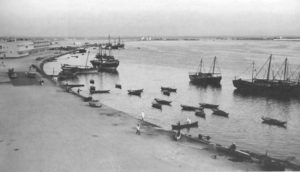
The Deira side of Dubai Creek in 1964, after reclaimed land had been added to the shore. Dhows were offloaded by smaller vessels. Port Saeed would be developed further upshore in photograph’s background.
The plan included recommendations by British engineers to dredge the creek and harden its edges, stripping away the creek’s remaining natural characteristics. Dredging allowed larger boats to arrive at any time of day; the dug-up earth was used to create new land on the creek’s edges. British engineering created new real estate potential and British legalese helped ensure that all land created from the creek would be owned by the ruling family – part of that land included where Port Saeed, Aladdin City’s designated site, would eventually be built.
Based on the first master plan, it seemed that Dubai would remain centred around the port that had allowed it to survive. But there’s a hint otherwise in the plan – an unusually large roundabout where there was clearly no need for one. By drawing this roundabout, the architect revealed a tip to the engineer, who seemed to be playing a universal survival trick of consultants: when you finish with one project be sure to have the next project set out for you. Another even more modern port was recommended by British engineers and financed thanks to a British government that worked as an equity collector. Port Rashid would be announced even before all the improvements on Dubai Creek had been completed: its dredging schedule invited even larger ships than Dubai Harbour could contain, though the technological advancements were not much beyond those already offered. Ships at Port Rashid would still be loaded and unloaded by men from different parts of the world, usually wearing lungis and often without proper footwear.
Technological advancement would be reserved for the next port development project because, as with last time, the next would begin before the previous was finished. British bankers and engineers announced with Sheikh Rashid the launch of Dubai’s Dry Docks development. In similar fashion, Dubai’s second master plan of 1971 was already obsolete when it was published. It included what would become the famous highway of skyscrapers known as Sheikh Zayed Road, but the plan’s boundaries didn’t extend far enough for Dubai’s economic planning. Within a matter of months after the release of the plan, Dubai’s ruler was in touch with his British engineers to build yet another port well beyond the confines of this plan. Port Jebel Ali would be dug about 25 miles further out and close to the border of the next emirate, Abu Dhabi. Once again, it would be a combination of global marketing, geopolitical grandstanding and British engineering and financing that would launch what was without a doubt a technological feat. Port Jebel Ali was billed as the world’s most advanced port and also one of its largest. It not only made Dubai’s ruling family feel assured of its modern credentials: it also made Great Britain’s head of state, Queen Elizabeth II, proudly claim that Port Jebel Ali was a crowning achievement of British engineering, if only several thousand miles away from home.
This very quick history of Dubai’s port development reveals how Dubai’s modernization has been associated with spatial expansion. In other words, economic and urban development did not mean replacing original conditions but adding on to them. Dubai’s modernization – or, interchangeably, its urbanization – has always been associated with spatial expansion.[10] Spatial expansion has also been about expression of a sovereign existence, namely by occupying important borders and an urban sprawl that constituted Dubai’s physical existence. In this way new development has never intentionally replaced old. That is why today, one can speak of an Old Dubai and a New Dubai – not as temporal conditions, but spatial ones.
Old Dubai and New Dubai are places that coexist and may not be dependent on one another. In both, one may take rides across waters on water taxis known as abras; Old Dubai’s abras are considered authentic, while New Dubai’s are considered fake. Old Dubai is comprised of districts that concentrate on Dubai Creek and are characterized by Dubai’s initial forays into modern architecture. The buildings, though, may not be that old: they could easily be third or fourth-generation building stock. New Dubai is just about everything else but is most often represented by images of new opulence like the Burj Khalifa and Madinat Jumeirah. The cleft between Old Dubai and New Dubai is one of the main reasons why people speak of a city that rose from the sands: such an observation is made by those who have not ventured into Old Dubai. Even from the top of the Burj Khalifa, the world’s tallest tower, Old Dubai is hidden in shadows of dust.
This spatial strategy of expansion was how Dubai developed until around 2010 when the project Jumeirah Gardens was announced. Jumeirah Gardens included the world’s-tallest tower (if personal recollection is correct, the intention might have been for the building to revolve), luxurious villas, gardens and even its own metro line. The historically significant fact about this project is that it was going to require the demolition of a large swath of ‘Old Dubai.’ For the first time Dubai’s authorities were pursuing a large-scale erasure of its spatial and economic modern history. The demolition focused mostly on residential villas where some local Emirati families still lived, though most had already moved out to rent their homes to low- to mid-income expatriates. Neighbourhoods were levelled, or scheduled to be levelled, including one of Dubai’s most vibrant South Asian commercial districts, Al Satwa. The financial crisis saved Al Satwa’s main retail spine at least for the time being.
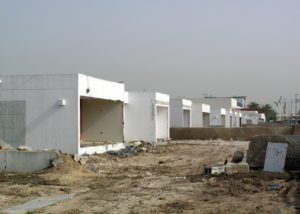
Houses in Al Satwa being demolished for Jumeirah Gardens, 2009. Photo: Todd Reisz
Wrecking balls in Al Satwa meant that there was likely little time before bulldozers would be directed toward that original root of Dubai’s economic prowess: the neighborhoods around Dubai Creek. Even the famous dhows that had created the picturesque tableau were threatened with extinction. In the name of modernization, the dhows are being displaced to a “wharfage development project with integrated infrastructure that will facilitate increase in dhow trade.” The cleanup includes dhows and wharves at Port Saeed.
To wish for Port Saeed’s preservation is not to pine for an ancient seafaring culture. Port Saeed itself was a significant modernization project. Originally, the port was a means of organizing and controlling the presence of dhows on the creek. It was started in the 1970s, well after Dubai’s ambitions were aimed at Port Jebel Ali, evidence that economies continued in Old Dubai even after they were no longer the focus of the media spin.
Today, Port Saeed makes for a memorable stop when in Dubai and not just because each visit might be one’s last. On the piers and on land under the palms is a “bustling” assembly of sailors and stevedores. It has been a place that affirms the existence of a continuing Indian Ocean trade culture – the cross-cultural merger of ethnicities, religions and natural and unnatural resources for the sake of economic well-being. Dhows are also mobile homes for men from Pakistan, Iran, India and Iraq. One might catch a sailor taking a bucket shower on deck. The men on these boats exist in a Dubai that runs parallel to the Dubai we most often read about. But their Dubai is no less relevant. Their boats go to the places of origins of their sailors but also to Somalia, Yemen and Sudan. A recent article reveals how influential and current the dhows’ commercial networks remain, as they “look to war-torn Yemen for business.”[11] Such a context manages to complicate our understanding of regional politics.
But let us return to Aladdin City – a revisit that just might include an element of hope for the preservation of Dubai Creek’s current condition. Might dhows have a chance at survival? Aladdin City’s computer renderers have included cartoon versions of the dhows in their images, after all. By tapping into our impressions of Aladdin, Dubai is suggesting that its buildings can float above an economy now threatened with extinction for the sake of spatial renewal, or spatial editing. Still, can an economy of advanced building technologies addicted to the high returns of the tourism industry make these bulbous buildings levitate above the dhows? Could it be that a mirage of an Arabian Nights fantasy will save the dhows and the boatmen’s day jobs as long as they promise to perform a part in the new theatre, to create the scene of exhibition viewed from the blue glass above? Whereas critics fear that Aladdin City will bring about the obliteration of an old scenic place and a reliable, still very relevant economy, could Aladdin City be the cosmopolitan fantasy that saves a cosmopolitan past? If only buildings could float.
Addendum: Some time after the media blitz around Aladdin City, images for the project could no longer be found on Dubai Media Office’s Twitter feed or website. Inquiries at the Dubai Municipality led to questions as to whether the project had ever been proposed. In any case, it is no longer on the municipality’s official projects list. Aladdin City, however many times it has been launched with a rendering, would not be the first development project in Dubai to disappear as quickly as it arrived. Meanwhile there have been indications that there are other proposals for transforming Dubai’s creekside. Stay tuned.
Endnotes:
[1] Christopher Smith, “Aladdin City: Sailing Into Dubai’s Future,” Clapway website, 13 February 2015, http://clapway.com/2015/02/13/aladdin-city-sailing-into-dubais-future403/.
[2] Parag Deulgaonkar, “‘Aladdin City’ work to start next year,” Emirates 24|7, 12 February 2015 http://www.emirates247.com/news/emirates/aladdin-city-work-to-start-next-year-2015-02-12-1.580477.
[3] A side note: The project isn’t too far off from looking like an earlier proposal for the famous Kuwait Towers but there are stories about the Kuwaiti leadership wanting them to look like perfume bottles. Kuwait, it seems, has more of a potential claim on Sindbad. The Gulf’s modern times – as late as it is often described as beginning – is often full of its own mythologies that can be neither confirmed nor denied.
[4] See the YouTube video, which was found on the Skyscrapercity.org feed about Skyscraper City: “THE DUBAI GUYS,” 12 July 2012 http://www.skyscrapercity.com/showthread.php?t=1528926.
[5] Architects might be reminded of another project that used the The Arabian Nights for source material: Frank Lloyd Wright’s plan for Baghdad, one project that is a blizzard of Orientalist fantasy.
[6] The stories were first published as Les Mille et Une Nuits by Antoine Galland between 1704 and 1717.
[7] In Colonising Egypt (1988), Timothy Mitchell introduces this term as a variation on Heidegger’s “age of the world picture.”
[8] Neha Vora, Impossible Citizens: Dubai’s Indian Diaspora (Durham and London: Duke University Press, 2013).
[9] Rupert Hay, “The Persian Gulf States and Their Boundary Problems,” The Geographical Journal 120.4 (1954): 433-443. Thanks to Tabitha Decker for sharing this reference.
[10] Ahmed Kanna makes the link between modernization and urbanization in Dubai, the City as Corporation (Minneapolis: University of Minnesota Press, 2011).
[11] Alexander Cornwell, “Dubai’s dhows look to war-torn Yemen for business,” Gulf News, 11 April 2015 http://gulfnews.com/business/sectors/shipping/dubai-s-dhows-look-to-war-torn-yemen-for-business-1.1489897.
